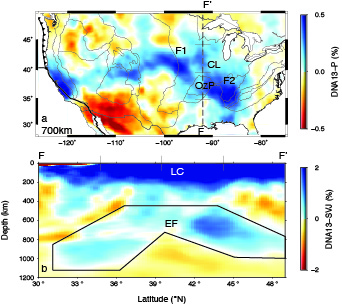| Home |
| Research |
| Downloads |
| Publications |
| Teaching |
| People |
| Press |
| Allen CV |
| Seismo Lab |
| Earth & Planetary |
| UC Berkeley |
|
Seismic imaging east of the Rocky Mountains with USArray
Robert W. Porritt
Earth Planet. Sci. Lett. , in press,
Download a preprint:
Data products and downloads:
|

|
Abstract
USArray has facilitated significant advancement in tomographic models and methodologies. While there persists a fundamental tradeoff between horizontal and vertical resolution due to the components of the wave train analyzed, advances in joint inversions are continuing to refine the tomographic images generated with USArray. The DNA13 model incorporates teleseismic P observations, independent SH and SV observations, and surface-wave phase velocities from both teleseismic earthquakes and ambient noise to constrain the relative wave-speed from the crust down into the lower mantle. We address the validity of our models through forward prediction of observables and compare the predictive power of the DNA13 models to other models. In the shallow portion of DNA13, we image the Archean age Wyoming Province, which exhibits evidence of ocean closure at its northern and southern ends. The Llano Province in Central Texas is of Grenville age and still contains lithospheric evidence of subduction as the province accreted to North America. Comparison of these two provinces highlights the role of fossil slabs as part of the cratonic architecture. Analysis of the deep portion of the models highlights variations within the Farallon plate, including two distinct high wave-speed anomalies in the eastern U.S. and a shallow feature in the center of these two anomalies. We propose this is evidence of an oceanic plateau, which provides the necessary positive buoyancy to promote flat-slab subduction of the Farallon plate.
